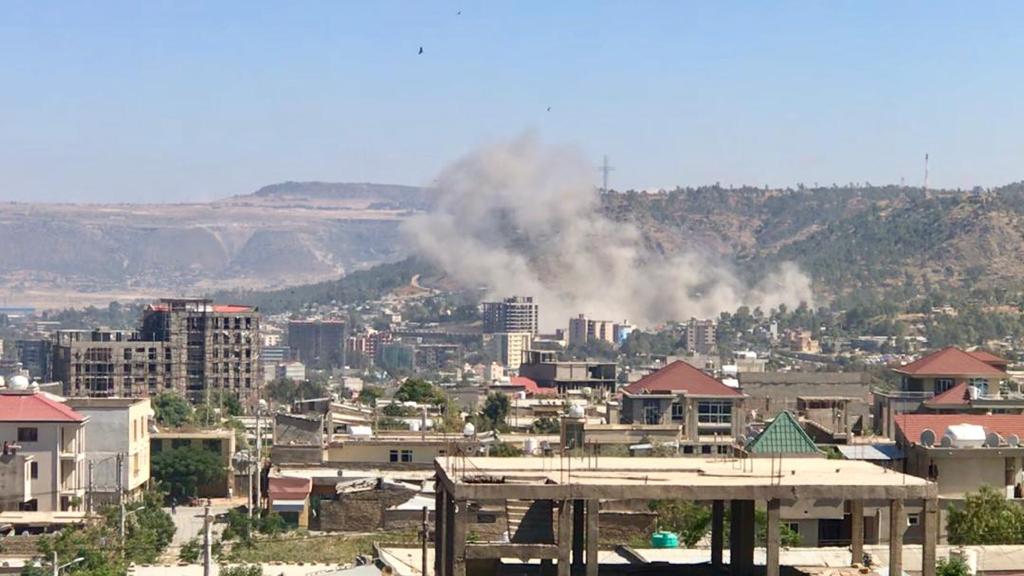More languages
More actions
No edit summary Tag: Visual edit |
No edit summary Tag: Visual edit |
||
| Line 13: | Line 13: | ||
== War crimes == | == War crimes == | ||
=== Airstrikes on civilians === | |||
[[File:Mekele.jpg|thumb|Aftermath of an Ethiopian airstrike in [[Mekelle]], the capital of the Tigray National Region State.]] | |||
{{Main article|Airstrike}} | |||
Both Ethiopian and Eritriean forces have engaged in air strikes against civilians in the Tigray National Regional State.<ref>[https://www.hrw.org/news/2021/02/11/ethiopia-unlawful-shelling-tigray-urban-areas Ethiopia: Unlawful Shelling of Tigray Urban Areas]</ref> | |||
=== Ethnic cleansing === | === Ethnic cleansing === | ||
Revision as of 21:19, 2 August 2022
The Tigray War, part of the much larger Second Ethiopian Civil War, is an ongoing revolution in the Tigray National Regional State and neighboring regions led by the Tigray People's Liberation Front (TPLF) against the Federal Democratic Republic of Ethiopia. The revolution was a response to the racially motivated anti-Tigrayan policies by Abiy Ahmed's administration.[1] While the war initially seemed as if the Ethiopian government was going to be able to squash the TPLF's revolution, the Tigrayan forces have managed to fight off the Ethiopian regulars and have managed to turn the war in their favor.[2] Abiy Ahmed's administration has continued to try and forcefully squash the rebellion, which has only further fanned the flames of the Tigrayan insurrection.[3]
Foreign involvement
State of Eritrea
The State of Eritrea has deployed troops into the Tigray National Regional State, using their military to fight in active combat against the TPLF.[4] While the Eritrean government promised to pull their troops out of Tigray in April of 2021, they have yet to withdraw from the conflict.[5]
United Arab Emirates
The United Arab Emirates has provided military support to the Ethiopian government, especially in air combat.[6][7]
United States of America
Prior to the war, the United States of America was a firm ally of Ethiopia. Initially, the Trump administration didn't take any action during the conflict when it began in November of 2020. After the Biden administration came to power in January of 2020, the United States began advocating for setting up humanitarian corridors. Despite this, Biden has still refused to condemn the Ethiopian government's war crimes in the conflict.[8] Eritrea has alleged that the United States is supporting the TPLF,[9] however these allegations contradict the actual actions taken by the Biden administration.
War crimes
Airstrikes on civilians

See main article: Airstrike
Both Ethiopian and Eritriean forces have engaged in air strikes against civilians in the Tigray National Regional State.[10]
Ethnic cleansing
See main article: Ethnic cleansing
Over the course of the Tigray War, the Ethiopian government under Abiy Ahmed has taken actions of ethnic cleansing against the Tigrayan people, forcing them out of the military regardless of loyalty.[6] Abiy Ahmed has also purged ethnic Tigrayans from the government.[1] In the western parts of the Tigray National Regional State, Ethiopian forces have taken actions of ethnic cleansing against regular civilians.[11] The Ethiopian government has tried to hide evidence of ethnic celansing back blocking telecommunications with Tigray.[12]
References
- ↑ 1.0 1.1 Ethiopia’s Tigray crisis: Socialism or barbarism
- ↑ Ethiopia: the fall of Mekele marks a turning point in the war in Tigray
- ↑ What is behind the war in Tigray?
- ↑ Ethiopian PM confirms Eritrean troops entered Tigray during conflict
- ↑ Eritrea confirms its troops are fighting in Ethiopia’s Tigray
- ↑ 6.0 6.1 Ethiopia's war in Tigray turns into defeat
- ↑ UAE air bridge provides military support to Ethiopia gov’t
- ↑ Ethiopia’s War Leads to Ethnic Cleansing in Tigray Region, U.S. Report Says
- ↑ Eritrea blames US support for Tigray’s leaders for the war
- ↑ Ethiopia: Unlawful Shelling of Tigray Urban Areas
- ↑ Crimes against Humanity and Ethnic Cleansing in Ethiopia’s Western Tigray Zone
- ↑ “Dying by blood or by hunger”: The war in Ethiopia’s Tigray region, explained
